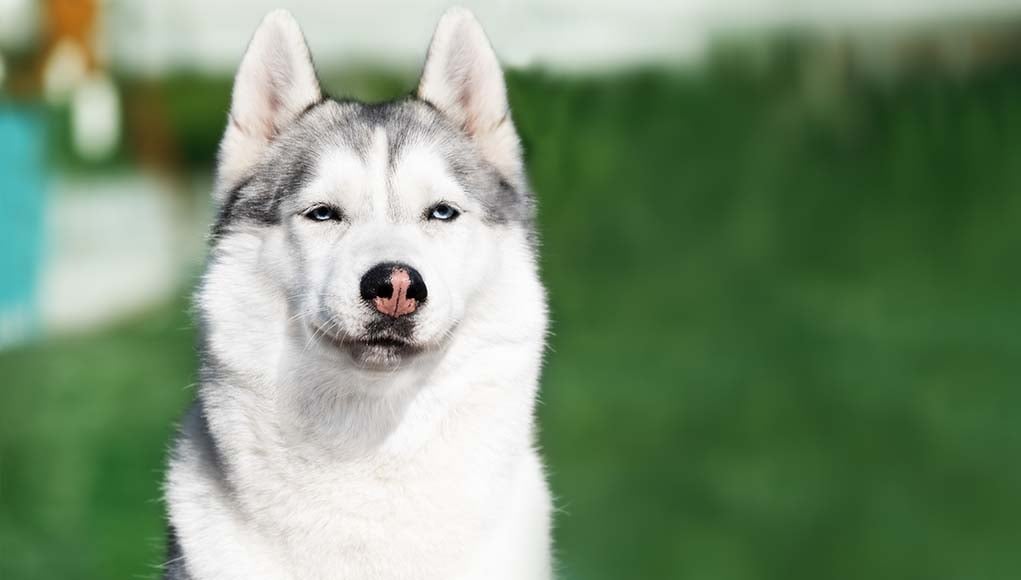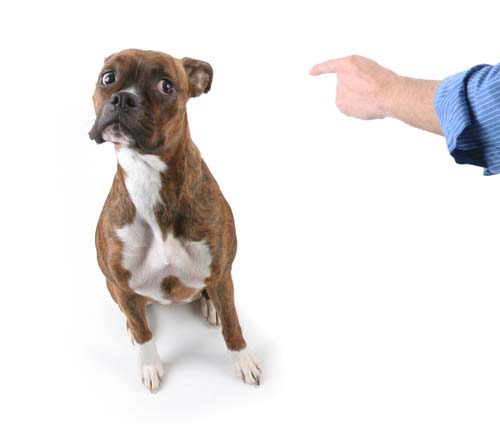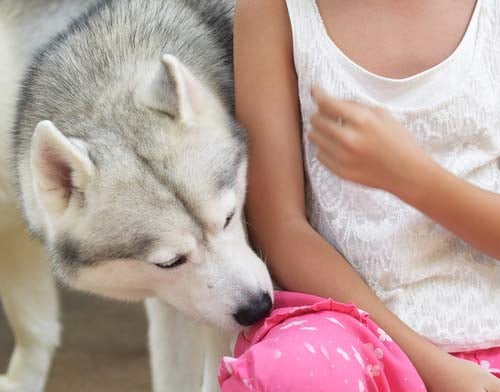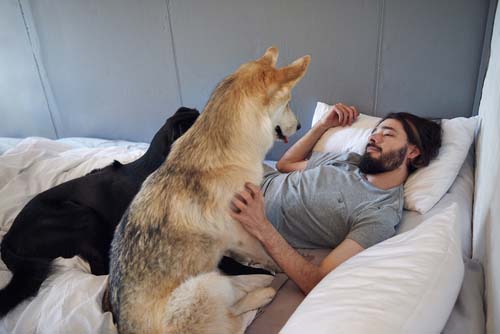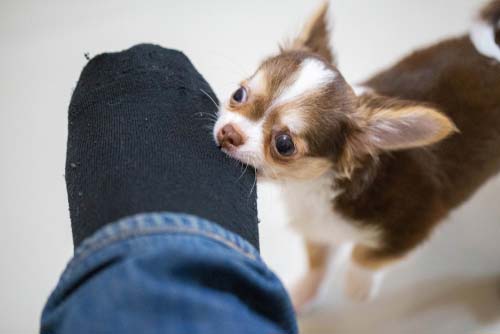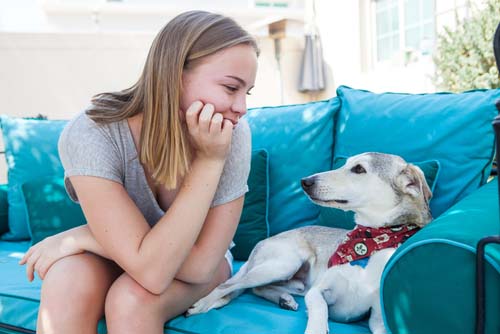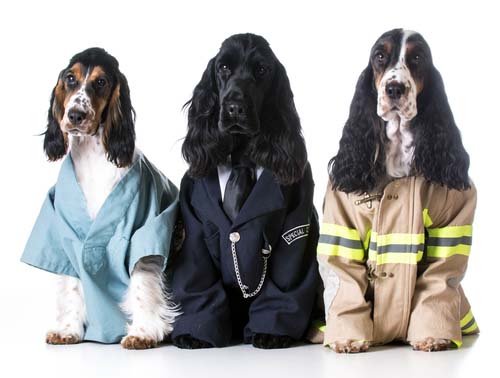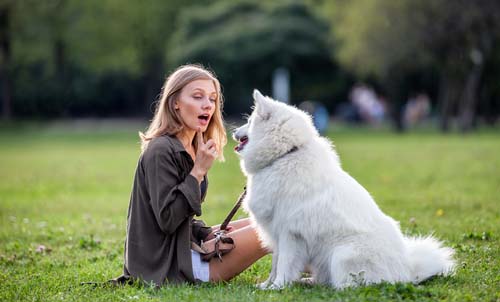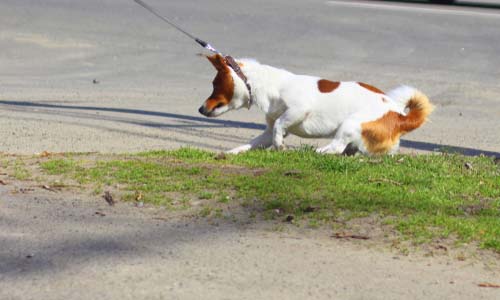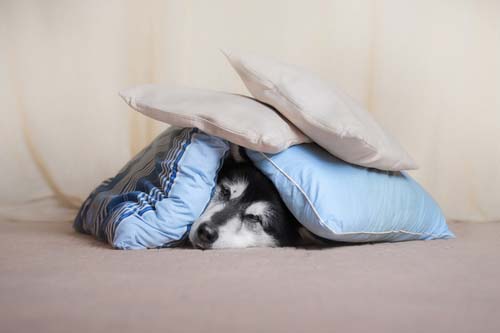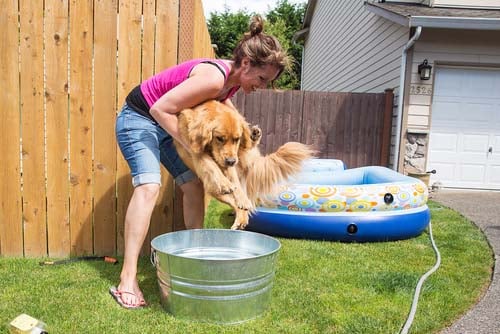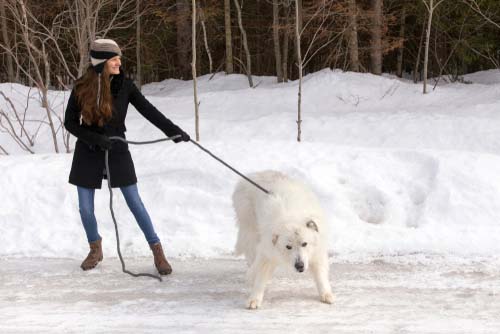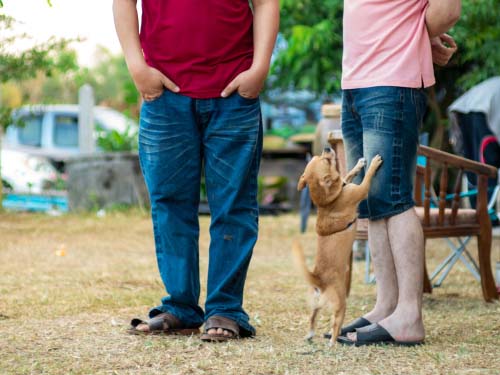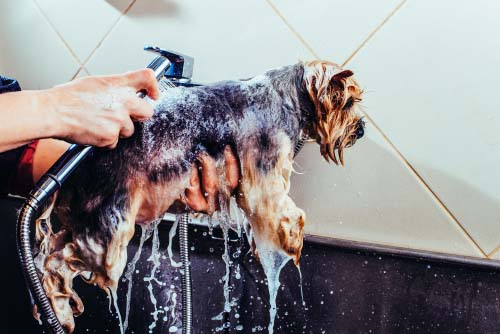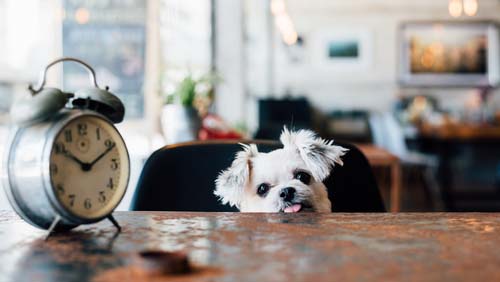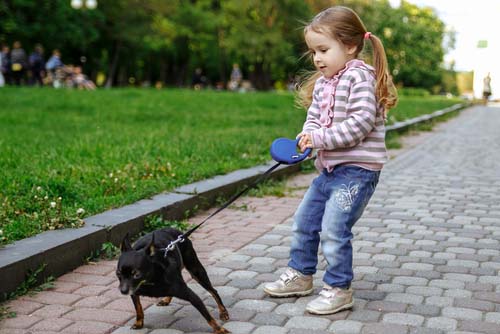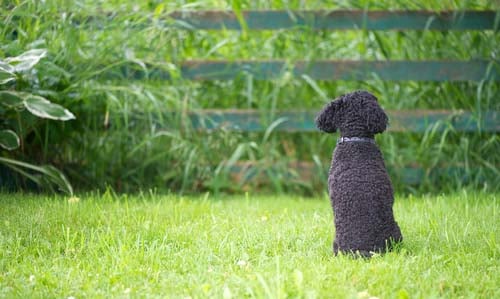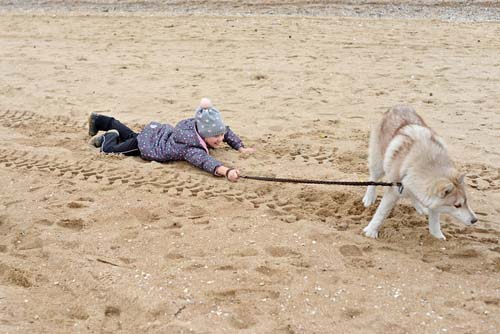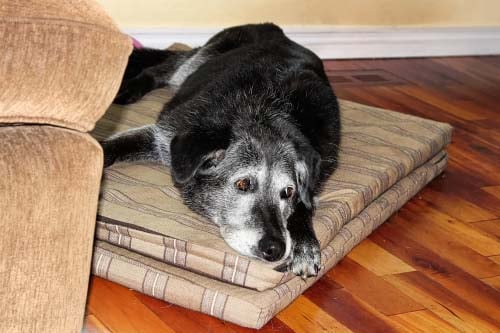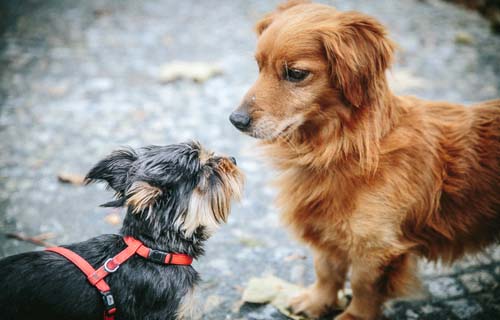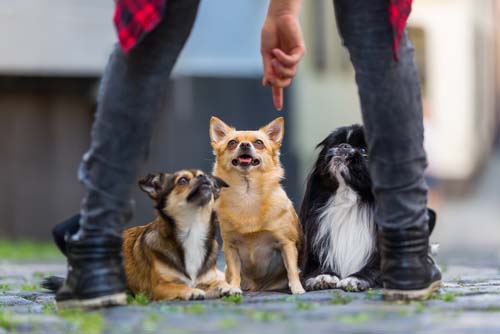As dog parents, we like to think that we understand our pets well, but sometimes our efforts aren’t as well received as we’d like to think. They get, as you would say, lost in translation. If you'd like to understand your pooch better and communicate more accurately, here are some of the things that dog owners do that their dogs generally dislike.
1. Hugs
Most dogs don’t enjoy hugs.
In our world, hugging is a way of showing affection, but in the canine world hugging is more of an expression of dominance and is interpreted as threatening behavior.
Does your dog tolerate hugs from you? Yes, most dogs will tolerate hugs from trusted humans in their lives, but that doesn’t mean that they enjoy them.
Instead of forcing your dog into a hug that will make them feel uncomfortable, allow your dog to seek out affection from you and when they do, pet their chest or back, or if THEY initiate it, their head.
2. Punishment
Dogs learn from positive reinforcement.
While dogs will comply with punishment, it’s not an effective or necessary tool for teaching your dog. Positive reinforcement is a much more beneficial training tool because it creates a stronger bond between you and your dog.
Just because your dog responds to punishment doesn’t mean that it’s working…in fact, it’s confusing your dog and teaching them that they can’t trust you.
Instead of using negative reinforcement or punishment when working with your dog, focus on rewarding desired behavior and knowing that non-compliance is a result of poor communication on YOUR part.
3. Overpowering Cologne or Perfume
Dogs do not enjoy strong smelling cologne or perfume.
Dogs have an incredible sense of smell; it’s estimated to be anywhere from 10,000 to 100,000 stronger than our own. Now, imagine your discomfort when you get into an elevator with someone wearing strong cologne or perfume and multiply that exponentially.
Strong scents can easily overwhelm your dog’s sense of smell and cause irritation and sneezing. The same goes for wearing too much cologne or perfume.
For your dog’s comfort, avoid wearing excessive scent or overpowering scents, instead, stick with subtle scents or for special events, apply stronger perfumes and colognes once you leave the house. Remember that dogs do have their favorite smell – it's their owners natural scent.
4. Getting Up Late
Dogs don’t quite understand the concept of weekends and days off the way that we do.
Dogs thrive on schedule because it lets them know what to expect and it allows them to predict what will happen next based on previously scheduled activities. Structure is a way for your dog to understand their world even when their family speaks a different language and is of a different species.
When you break routine by getting up late, you confuse your dog and leave them feeling unsure and unnerved, because their ability to predict what happens next is in question. You also make your dog wait for one of the most enjoyable moments of their day! It may cause stress in the dog and increase levels of anxiety.
If you enjoy sleeping in on weekends or on your day off, get up with your dog, take them out, give them breakfast, then crash on the couch or go back to bed or invest in a dog walker to do that for you!
5. Invading Their Personal Space
Dogs, like humans, need their personal space to be respected.
No one likes to have their personal space invaded; it’s uncomfortable and threatening. When we invade our dog’s personal space, we make them feel the same way particularly because we are a much larger species.
When you make your dog feel intimidated by closing in on their personal space, they are pushed to defend themselves or in the very least, retreat in fear.
Rather than making your dog feel uncomfortable, allow your dog to come to you and watch their body language for signs that you are overstepping your bounds.
6. Being Ignored
Do you like being ignored? Your dog doesn’t either.
When your dog comes to you to play, they are showing you affection, asking for your attention and wanting to interact with you.
You are one of the few interactions that your dog has daily. When you refuse to play with your dog or you ignore their requests for interaction you are not just showing a lack of interest, you are depriving them of one of the few interactions that they get to experience after being home alone all day while you’re at work.
Instead of ignoring your dog’s need for attention, take some time out and play with them and remember that your dog’s life is short and you are the center of their world.
7. Teasing
There is no excuse for ever teasing your dog.
When you tease your dog it can be interpreted by them in a couple of ways. 1) You are playing a game or 2) You are challenging them for possession of the item. Both of these situations incite excitement and a need to act.
If you’re lucky, your dog will think your teasing is a game and engage in play, if you’re not, you stand a good chance of being bitten.
Nothing good comes from teasing, treat your dog kindly and teach your children to do the same.
8. Not Paying Attention to Their Body Language
Your dog does not speak English and likewise, you do not speak canine.
Gestures, sounds, movements, expressions can all convey a lot of information about how we feel without a need for a commonly spoken language.
When you ignore your dog’s body language you can easily overstep boundaries and make your dog feel uncomfortable or threatened and push them to react.
Always pay attention to your dog’s body language and observe a situation before you act so that both you and your dog can have clearer lines of communication.
9. Sustained Eye Contact
For dogs, sustained eye contact is a threat and a signal of aggression and dominance.
When you glare at your dog for a long period of time, they may not have too much of a reaction because they are comfortable around you, but this isn’t always the case (even more so when you hold sustained eye contact with a dog that you don’t know).
Holding a dog’s gaze is going to make them feel uncomfortable and depending on your dog’s personality it could lead them to get up and walk away from you, feeling threatened and unsafe, or it could lead to a confrontation and aggression.
Rather than holding any dog’s gaze for an extended period of time, avoid staring altogether. If a strange dog is loose and you need to keep an eye on them, look down and to the side of the dog rather than directly at them (try focusing on a paw instead of the eyes). This will allow you to monitor the dog’s movements without making them feel threatened.
10. Being Forced to Dress Up
In general, dogs do not care to be dressed up.
When you dress up your dog, you are putting them in constrictive clothing that hampers their natural movement. You are also making them feel confined which leads to feelings of discomfort and wariness.
Although sometimes we must dress our dogs in a coat or booties to keep them safe and warm during walks, it’s important not to push your dog beyond their comfort zone by forcing them to wear unnecessary clothing.
When considering dressing up your dog for Halloween, pay attention to their body language and if they show signs of discomfort or wanting to escape, stop what you’re doing and leave them alone.
11. Repeating Commands Over and Over
We’ll say it again – dogs don’t speak human and humans don’t speak dog.
When we train our dogs to follow commands, they are learning to identify a single action with a single word or short phrase because successfully completing that action yields a tasty treat. Our dogs aren’t learning English so much as they’re learning to identify a pattern that they want to replicate.
Your dog wants to please you because it means that they receive a reward. So, when you give your dog a command and they don’t follow it, stop saying it repeatedly and expecting a different outcome. If your dog “doesn’t listen” to a command, realize that they may not have understood what you said, they may have forgotten what that series of actions was, or they may have an external factor like pain that is preventing them from completing the command.
Rather than repeating the same command over and over, if your dog fails to respond the second time you give a command make sure that they are not in pain or discomfort and then work at teaching the command again (and this time be clearer!)
12. Dragging Your Dog Away from Smells When You Go Walking
When dog’s make multiple “pitstops” on walks they are leaving their own scent as well as taking in the scents that other dogs have left behind.
These scent “postcards” are a way for dogs to communicate with each other as well as to learn more about their surroundings.
When you take your dog out for a walk and don’t give them time to take in those scents it’s like taking your child to a playground but not letting them talk to friends or play on the equipment!
Rather than drag your dog when you’re on your walk, take the time to walk at a leisurely pace, let your dog smell the “postcards” left by friends and leave their replies, and stop being in such a rush all the time.
13. Loud or Overwhelming Sounds
A dog’s hearing is over four times better than a human.
Our dogs also have a much larger frequency range of hearing than humans with a human hearing sounds between 20 and 20,000Hz and a dog hearing sounds between 40 and 60,000Hz.
So, when you play your surround sound louder than you should, when you think your dog will enjoy that outdoor concert with you, and when you take your dog out to watch fireworks with you, you are really making your dog very uncomfortable.
Rather than torture your dog with things that you enjoy, keep their enhanced hearing in mind and leave them at home to enjoy the silence while you go out and have fun.
14. Forcing Your Dog to “Face Their Fear”
Just like us, our dogs have fears that are influenced by a wide range of factors.
When you force your dog to face their fear you are not only making them feel incredibly uncomfortable, but you are betraying your dog’s trust in you as their caretaker.
To make the situation worse, because your dog doesn’t speak the same language as you do, you can’t explain to them why you are doing what you are doing.
Rather than force your dog into facing their fear, treat them humanely and use positive reinforcement to slowly desensitize your dog to what they are fearful of at a pace that they are comfortable with.
15. Rushing Your Walks
No, we aren’t repeating ourselves…
When you take your dog out for a walk it’s not only a chance for your dog to explore their world, but it’s also a chance for them to spend time with you.
When you rush your dog through their walk it’s similar to going to dinner with someone and rushing through the meal. You are saying “I don’t have time to spend with you” and “what you want is not important”.
Rather than rush through walks with your dog, really spend time with them and enjoy your surroundings as much as they do.
16. Not Taking Them to Potty When They Tell You They Have to Go
When your dog tells you that they have to go potty, they mean that they have to go potty now.
You have spent time training your dog to tell you when they have to potty and your dog has come to trust that when they tell you that they need to go out, you will take them.
Forcing your dog to wait to use the bathroom after they have let you know that they have to go out, is uncomfortable for them and it takes advantage of your dog’s trust in you.
Rather than make your dog wait, when your dog tells you that they have to go, take them out at that moment.
17. Being Neglectful of Playtime
Every dog needs playtime in their everyday life.
For dogs, playtime is more than “fun”, it’s a chance to bond with you, to exercise their natural instincts, an opportunity for mental stimulation, and an opportunity for stress relief.
When you don’t take part in playtime with your dog or you halfheartedly take part in playtime, you are depriving them of all of these things.
Rather than miss out on playtime with your dog, take the opportunity to bond with them and enjoy the stress relief yourself!
18. Baths
Some dogs enjoy baths… many dogs do not.
Although baths are necessary for your dog’s health occasionally, they are not something that should be done too frequently because they deplete your dog’s coat of essential oils and dry their skin.
Although some dogs do enjoy taking a bath, for most dogs, there are many things that make it an unpleasant experience, for example:
- Overpowering scents of shampoos
- Slippery bathtubs that make it hard to grip and stand
- Being confined in a tub in a small bathroom
- Being held in one place without the freedom to escape
- The sting of soap in their eyes
- Water that is too cold or too hot
Rather than forcing your dog through an unpleasant bathing experience, bathe your dog only when necessary (for most dogs that’s a couple of times a year) and when you do, try some helpful bathing tools and these tips:
-
- Only use a shampoo formulated for dogs because human shampoo can be drying and have an overpowering scent.
- Put an extended length mat in the bottom of your bathtub to help your dog to stand and grip the bottom of the tub.
-
-
- Use positive reinforcement to teach your dog that bath time can be fun so that eventually, you can leave the bathroom door open while you bathe them! (We recommend trying a lick pad with peanut butter on it to keep your dog occupied!)
-
- Don’t be forceful when giving your dog a bath, rather than grabbing them by their collar, try getting in the tub with them and making bath time a calmer experience.
- Keep soap and shampoo away from your dog’s face.
- Test the temperature of the water before you begin bathing your dog and monitor it throughout bath time!
19. Not Keeping a Regular Routine
All dogs prefer their schedule and knowing what's coming.
We mentioned the importance of routine earlier when we talked about how much your dog hates it when you sleep late, but this isn’t the only part of your dog’s life that relies on routine.
Your dog has little control over their life and so schedule becomes exceptionally important. Your dog eats on a schedule, goes out on a schedule, judges, when you will and will not be home on a schedule… all of these things, create a structure.
When you don’t keep your usual routine, you take away the structure that your dog relies on for stability and leave them feeling anxious as well as disoriented.
Rather than regularly breaking a routine, do what you can to keep the structure in your dog's life; for example, use an electronic feeder with a timer to always feed them on time and hire a dog walker for potty breaks if you need to!
20. Inconsistent Commands
We teach our dogs commands to provide them with an understanding of what is expected of them.
We use simplified commands and positive reinforcement to make this process easier.
When we use inconsistent commands – for example switching the words that we use for commands or expecting different things from the same command – however, we create confusion and cloud our dog’s understanding.
Rather than confusing your dog, create a basic vocabulary of commands, stick with it, and make sure that your family members stick with it too!
21. Leaving Them Alone for Long Periods
Dogs are social animals.
To be happy and secure, our dogs require a social interaction as well as a family or “pack” to call their own. This provides the opportunity for interaction, affection, bonding, mental stimulation, exercise, and simple companionship.
When we leave our dogs alone for long periods of time without companionship they lack for all of these necessary components of a happy life and begin to show signs of maladjustment including self-destructive behavior, poor socialization behaviors, depression, and other destructive behavior.
Rather than leave your dog alone for long periods of time, invest in a dog walker who can visit your dog daily, find a local doggy daycare, or ask about telecommuting or bringing your dog to work with you!
22. Not Teaching Your Children Respect
Dogs, like people, command and deserve respect.
As adults, we know to respect our dogs and we monitor their body language and verbalization for indications on what they need and how they feel.
Children are not as capable of understanding canine body language and respect is something they must learn as they grow. It is up to you to teach your child these things to ensure that miscommunications don’t happen and boundaries are not overstepped.
Begin teaching your child from an early age to respect all living things and help them to identify your dog’s body language signals and what they mean.
23. Being Left in the Yard to “Play”
A large part of what makes play fun for anyone is the social experience.
Playtime is a great outlet for energy, but it’s more than that, it’s also a chance to interact, socialize and bond.
When you leave your dog out in the yard to play alone, you are not just taking away an important part of play, but you are also leaving your dog preoccupied with your absence. Imagine if someone put you out on your own in the yard as a child with a soccer ball, told you to play, and left you. You may find a way to entertain yourself, but the “play” would not be the same and if you had little understanding of the situation, you would be left wondering why you were left alone.
Rather than leaving your dog in the yard to play alone, spend time with them. Play together and take the opportunity to bond and unwind.
24. Tugging on or Holding a Tight Leash
Dogs have an innate desire to explore and it’s this exploration that helps them to learn about and enjoy the world around them.
When you take your dog for a walk, this is a chance for them to find out information about their surroundings, to socialize with other people and animals, and to just enjoy their environment.
Keeping your dog on a short leash or repeatedly pulling or tugging their leash takes away from this experience and is just generally unpleasant.
Rather than constantly tugging your dog’s leash or keeping them on a short leash, allow your dog enough leash to explore but not so much that they can get into trouble. Finally, teach your dog how to properly walk on the leash to make the experience easier, and also how to be a good leash-free dog for those occasions.
25. Waking Them Up from a Deep Sleep
Nobody likes to be startled and our dogs are no exception.
When you wake your dog from a deep sleep, you startle them which is disorienting as well as frustrating. This can very easily lead to a startled response which can be anything from barking and growling to biting or even urinating.
It’s important to respect your dog’s space and their feelings of security so that these types of situations do not happen.
Rather than jolt your dog from a deep sleep, let them sleep or if you must wake them up, call to them softly or, if your dog is hard of hearing, tread heavily on the floor so that your dog can feel the vibrations of your feet.
26. Not Respecting or Recognizing Age or Health Related Changes
Dogs experience age and health-related changes in the same way that we as humans do.
These changes can include anything from pain due to arthritis, failing vision, loss of hearing, or the need to walk at a slower pace to accommodate for changing joints.
As your dog’s parent, you should always be aware of your aging dog’s health and any physical or mental changes that they are experiencing. Keep an eye on any symptoms that may indicate that your dog needs an adjustment to their usual routine activities and talk to your vet if you have any questions about how to better provide for your aging or ailing pup.
Rather than powering through daily life and sticking to your same routine, try to be more in tune with your dog and what they need from you as a guardian.
27. Not Paying Attention to Your Own Body Language
Body language is one of the most reliable ways for your dog to understand what you expect from them.
Dogs observe our body language to get clarification on what we are asking of them and how they are expected to act in a specific situation. This is how your dog can follow instructions from you even when you give them unfamiliar or more complex commands than they are used to.
When you are inconsistent with your own body language or you conceal your body from your dog when communicating with them, you take away a tool that they rely on for interpreting confusing or unfamiliar situations.
Rather than denying your dog this tool, understand how important it is to them and make the effort to be clearer in how you express yourself non-verbally.
28. Bringing Strange Dogs into Your Home Before a Proper Introduction
Dogs like to have a specific territory of their own, just like we like to have a place we call home.
In their own territory, a dog should be able to relax and let down their guard while enjoying their family and not have to worry about the availability of resources.
When you bring strange dogs into your dog’s territory without giving them a chance to meet on neutral territory first, you take away the security that your dog feels in their home.
Rather than allowing strange dogs to come into your home without a previous meeting, let your dog meet new strange dogs in neutral territory like a local park where neither dog is forced to feel on edge.
29. Unnecessarily Complicated Commands
Have we overstated the fact that dogs don’t speak English enough yet?
We teach our dogs basic commands that are generally based on one to three words. Our dogs learn what these words mean through a practice and reward process.
When you give your dog commands that are overly complicated, you are shrouding the keywords that they are searching for with words that they do not understand. This makes following your command much more difficult.
Rather than giving your dog lengthy commands, keep your commands as simple as possible and use the words that you have previously taught your dog to understand!
READ NEXT: How to Make a Dog Like You in 10 Easy Steps


